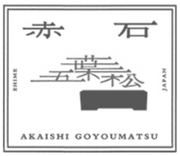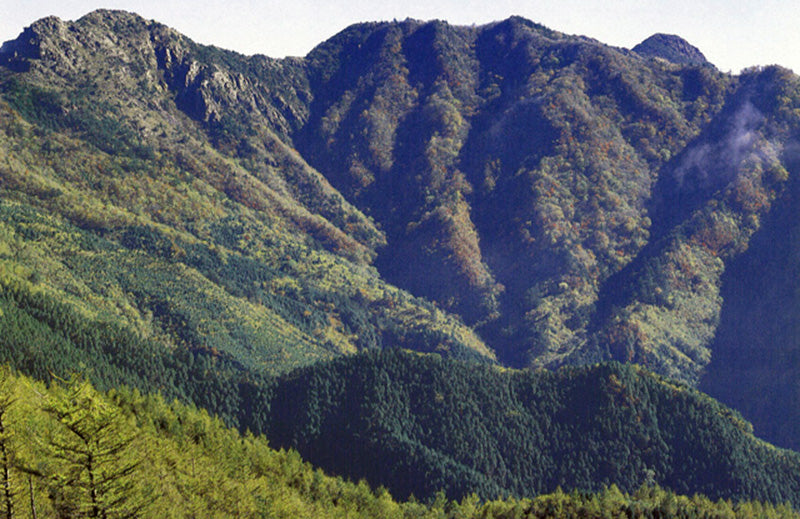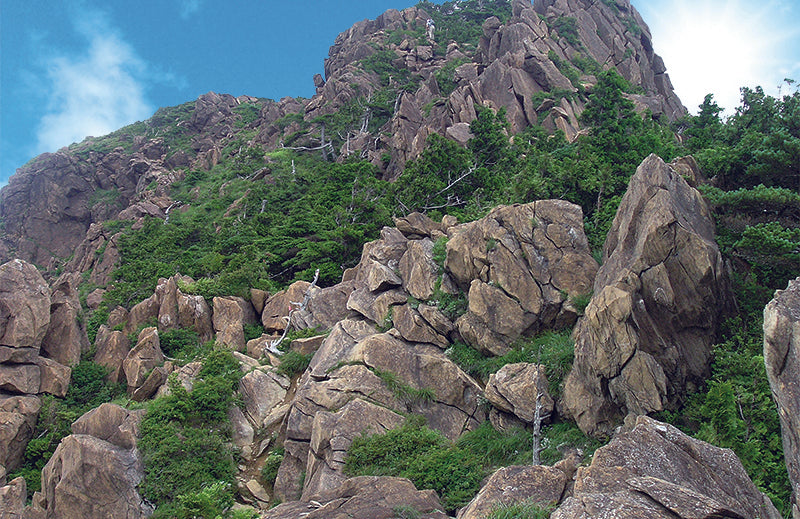-
Mt. Akaishi
A mountain of plants and history, popular with mountaineers, where a variety of alpine plants grow wild

Akaishi mountain range
The Akaishi mountain range is a mountainous area extending from Niihama City to Doi Town in Uma County in eastern Ehime Prefecture. The Akaishi mountain range stretches approximately 15 km from east to west and 10 km from north to south.
One of the tributaries of the Ishizuchi Mountain Range, the Akaishi Mountain Range consists of a series of mountains ranging from 1,400 to 1,700 meters, including West Akaishi Mountain (elevation: 1626 meters), East Akaishi Mountain (elevation: 1,706 meters), and Futatsudake (elevation: 1,647 meters).
Higashi Akaishiyama, Mt. Futatsudake, and Mt. Akahoshi (1453m above sea level), which is called "Iyo Kofuji" because of its solid appearance with a flat plaza at the top, are three of the most famous peaks in Shikoku and attract many climbers.
The ridges of the Akaishi mountain range, from the west face of Mae Akaishi to Gongen mountain (952m above sea level), centering on East Akaishiyama, are composed of peridotite, a rock with a high specific gravity that constitutes the earth's mantle (more than 10km deep underground).
The reddish-brown color of the rocks due to the participation of iron in the peridotite that forms Akaishi mountain is the origin of the name "Akaishiyama," and East Akaishi mountain in particular was called "Akataroo" in ancient times.
Tens of thousands of Goyomatsu trees with a long history grow wild in the Akaishi Mountain area, creating a vast primeval forest of Goyomatsu.
※Peridotite: A type of igneous rock (deep-seated rock) that is classified as an ultrabasic rock with low silicate (SiO2) content. Peridotite is a kind of igneous rock (deep-seated rock) that is classified as an ultrabasic rock with low silica (SiO2) content. It is formed when magma with low silica content (less than 45%) cools slowly and solidifies deep underground. It is a mosaic of yellow-green to green olivine, dark brown, green to greenish-black pyroxene (pyroxene and pyroxene), and black chrome spinel (isogranular structure). The density is very high (about 2.9 g to 3.5 g/cm) because it contains very few feldspars.
※The density of familiar stones found in gardens and on riverbanks is 2.0 g to 3.0 g/cm.
About East Akaishi Mountain

Higashi Akaishi mountain, the highest peak in the Akaishi mountain range, is located in the center of the Akaishi mountain range, on the border between Shikokuchuo City (formerly Doi Town, Uma County) and Niihama City (formerly Besshiyama Village, Uma County) in Ehime Prefecture.
The mountain is characterized by its rough rocky peaks made of bare peridotite, and the area around the summit is covered with coniferous trees, giving the mountain a unique shape and making it the greatest treasure house of alpine plants in Shikoku. It has been selected as one of Japan's Two Hundred Great Mountains, One Hundred Great Mountains of Flowers, and One Hundred Great Mountains of Shikoku.
At the top of the mountain is the third magnitude triangular point, which has been used as a standard for mapping and surveying.
The reddish-brown color of the oxidized iron in the peridotite combined with the color of the alpine plants gives the entire mountain an even darker reddish hue when the leaves turn red.
From the top of the mountain, you can see the mountains of Shikoku, including famous peaks such as Ishizuchi, Mt. From the north side of the mountain, you can see the islands of the Seto Inland Sea and, on a clear day, even Honshu.
| Location | Position | Mountain range | Elevation | Maximum temperature (June-August) | Minimum temperature (June-August) |
| Shikokuchuo City / Niihama City, Ehime Prefecture | 33 degrees, 52 minutes, 30 seconds north latitude, 133 degrees, 22 minutes, 30 seconds east longitude | Eastern part of the Ishizuchi Mountains - Hoho Mountains | 1,706.0 m | 20.6℃ | 8.1℃ |
Plants of the Akaishi Mountains and East Akaishi Mountain
The Akaishi mountain range is rich in alpine and sub-alpine plants, and is especially famous for its Tsuga cherry and redwood colonies.
The distribution of alpine plants at altitudes below 1,700 meters is due to special geographical factors that produce a variety of minerals, including the peridotite geology that covers most of Akaishi Mountain.
It is also believed that the reason why many alpine plants grow naturally despite the low altitude above sea level is because the Akaishi Mountain Range is exposed to strong southerly winds, creating a topography similar to the dry sand and gravel land characteristic of alpine areas.
In December 1957, the alpine plants of the Akaishi Mountain Range, including the "Goyomatsu" of Higashi Akaishi Mountain, were designated as natural monuments in accordance with Article 37 of the Ehime Prefecture Cultural Properties Protection Ordinance.
Akaishi Goyomatsu, also known as the "Queen of Bonsai", retains a lot of the life of the virgin forest of East Akaishi Mountain.
The distribution of alpine and subalpine flora in the Akaishi Mountains varies depending on the parent rocks that form the Akaishi Mountains.
For example, Tsugazakura and Akamono are distributed in the hornblende and crystalline schist areas, while the peridotite area is home to Cow Lily and Yukiwarisou. The Akaishi Goyomatsu is also unique to peridotite areas such as East Akaishi Mountain.
In the Akaishi Mountain Range, the Dou Mountain Peak (1300m above sea level) is home to the Tsugazakura cherry tree (designated in 1991 as a national natural monument "Tsugazakura community in Dou Mountain Peak" for its "high phytogeographic, ecological, and genetic value as a good native site at the southern limit of its distribution") and a large colony of comets azalea.
The Akamono grows wild over a wide area, and its white flowers bloom in late May, creating a beautiful sight.
The vertical distribution of vegetation is as follows: from 0m to 500m is a low mountain zone, from 500m to 800m is a warm temperate deciduous forest zone, and from 800m to the top of the mountain 1706m is a natural evergreen coniferous forest with black locust, Tsuga, cypress, and fir growing in the tall tree layer. The herbaceous layer is dominated by Miscanthus sinensis, Koshida, and bracken.
Geographically, between Dou Mountain Peak and the top of West Akaishi Mountain and Mae Akaishi, there are deciduous forests and mixed shrubland and sub-shrubland thickets such as Quercus mongolica, mountain willow, Ryoubu, Neziki, white maple, Daishen Mitsuba azalea, Kibanatsubane azalea, Akebonotsutsuji, Suzutake, Koyorak azalea, white dodan, Noriutsugi, etc., where you can enjoy azalea in spring and red leaves in autumn.
Geology of East Akaishi mountain
In the Akaishi mountain range in the upper reaches of the Seki River, which flows through Shikoku Chuo City and empties into the Seto Inland Sea, there are metamorphic rocks such as Higashi Akaishi peridotite and Iratsuryuronite hornblende (*metamorphic rocks formed under moderate pressure and temperature conditions, which appear yellowish green), as well as eclogite (*metamorphic rocks formed under high temperature and high pressure) and zakuroite hornblende (*metamorphic rocks formed from basic igneous rocks), which were formed by the highest degree of metamorphism in the Sanbagawa Belt. In addition to the metamorphic rocks formed under moderate pressure and temperature conditions, the Sambagawa Belt also produces rare domestic rocks such as eclogite (*metamorphic rock formed under high temperature and high pressure) and pomegranate hornblende (*rock that is believed to be basic igneous rock that has undergone metamorphism).
The area around East Akaishi Mountain is very important geologically and petrologically.
Compared to other rocks, the peridotite of East Redstone Mountain is characterized by low silicon dioxide, one of the important substances that form the earth's crust, high magnesium oxide, and extremely low calcium oxide, making it an ultrabasic rock.
It belongs to the Sambagawa Metamorphic Zone, where ultrabasic rocks are widely distributed, and is called the East Akaishiyama peridotite body, which is recognized as the largest of its kind in Japan. The northern slope is called the Gorazu Igneous Body, where hornblende, eclogite and other metamorphic rocks formed under high pressure can be found.
Serpentine is a rock formed by the alteration of peridotite by moisture in deep underground. Serpentine rocks are formed by the alteration of peridotite by water action deep underground, and are often pulverized at the periphery of the peridotite body and along faults and other weak lines.The same trend can be seen in the Akaishi Mountains.
The rocks have oxidized and turned red, which is the origin of the name Akaishi mountain.
In March 1976, the Akaishi mountain range, centered on East Akaishi Mountain, was designated as a nature conservation area in order to protect the good natural environment.1,790.34 hectares of nature conservation areas, 410 hectares are special areas that have been recognized as having a particularly good natural environment, and are still being protected in good condition.
The vast expanses of peridotite, such as the East Redstone peridotite body, are interesting from a geological and petrological point of view, and the geology of the area makes it unique in terms of vegetation due to its high magnesium content and strong basicity, making it a treasure trove of alpine plants and a botanically valuable area.
It is designated as a special protection area by Ehime Prefecture, and is home to many rare alpine plants. Yamaki Mountain, which is connected to Higashi Akaishi Mountain, is made of serpentine peridotite, and its reddish-brown surface is a rare alpine sight in Shikoku, making it a popular destination for climbers as well as researchers and experts.
The Akaishi Goyomatsu bonsai is an exceptional natural product born from the rarity of the natural world, the workings of nature and history.





